Harry Houdini
#Book Title: Echoes Of Genius: A Tribute To The Thinkers And Doers Who Shaped The World With Their Proven Merit
#Unit 1: Stars and Stripes Of A Dream, An American Dream
249 Years Young And Counting; A Tribute To The Science, Arts, Culture, and Philosophy Of US
#Chapter 1.1: The Impact and Influence of Three Entertainment Icons: The Magic of Houdini, Suspense from Hitchcock and Fairyland of Disney
#Section 1.1.1: The Magic of Houdini: Harry Houdini (1874-1926)
#Section 1.1.1.0: So Said Houdini
‘The object of this book is twofold: First, to safeguard the public against the practises of the criminal classes by exposing their various tricks and explaining the adroit methods by which they seek to defraud. ‘Knowledge is power’ is an old saying. I might paraphrase it in this case by saying knowledge is safety. I wish to put the public on its guard, so that honest folks may be able to detect and protect themselves from the dishonest, who labour under the false impression that it is easier to live dishonestly than to thrive by honest means.’–Quote by author Harry Houdini, from preface of his book ‘The Right Way to Do Wrong: An Exposé of Successful Criminals’.
#Section 1.1.1.1: Introducing Houdini
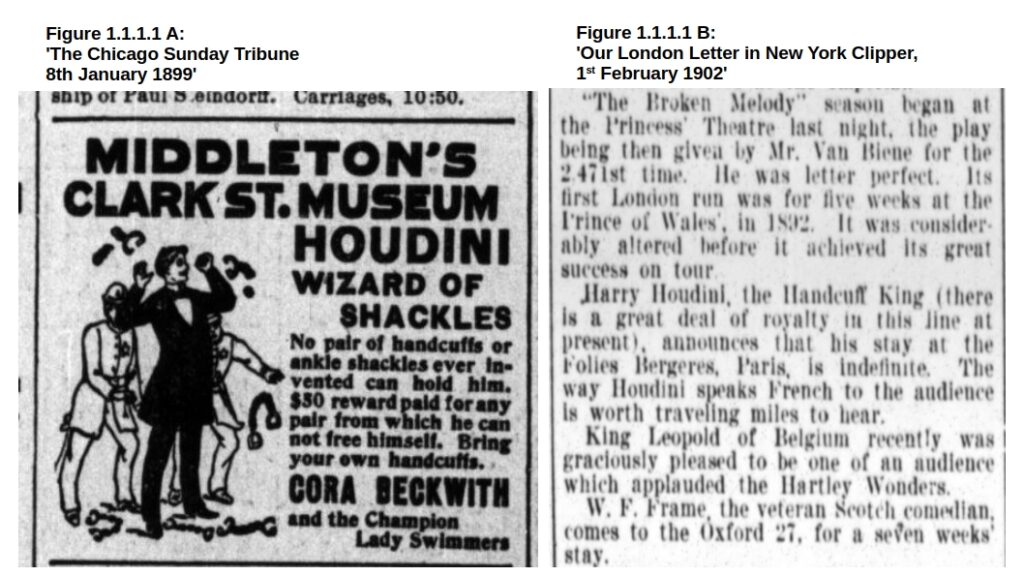
Figure 1.1.1.1A: ‘Houdini, Wizard Of Shackles…MIDDLETON’S MUSEUM—Houdini, the man who cannot be kept a prisoner by any pair of handcuffs or shackles, will be the leading feature’ Image and Quote from ‘The Chicago Sunday Tribune 8th January 1899’
Figure 1.1.1.1B: ‘Houdini, the Handcuff King…announces that his stay at the tolies Kergeres, Paris is indefinite. The way Houdini speaks French to the audience is worth travelling miles to hear.’ Image and Quote from ‘Our London Letter, London, England, 15th January 1902’ in ‘New York Clipper, 1st February 1902’
Harry Houdini, born Erik Weisz in Hungary, was an American who took the name Houdini inspired by French magician Jean-Eugène Robert-Houdin (1805-1871). Houdini’s, hometown was Appleton, Wisconsin, US, and he was the master magician, an illusionist, who pushed the boundaries of human potential. His daring escapes and mystifying illusions captivated the imagination of the American public, inspiring awe and wonder. His life in Wisconsin, a time of unparalleled magic and mystery, combined his magical skills with his ambition to prove himself as a master of deception. Houdini, primarily known as an escape artist and magician, was deeply committed to exposing fraudulent spiritualists and mediums who claimed to communicate with the dead, which demonstrated the importance of scepticism and critical thinking in uncovering deception.
#Section 1.1.1.2: Houdini Major Works
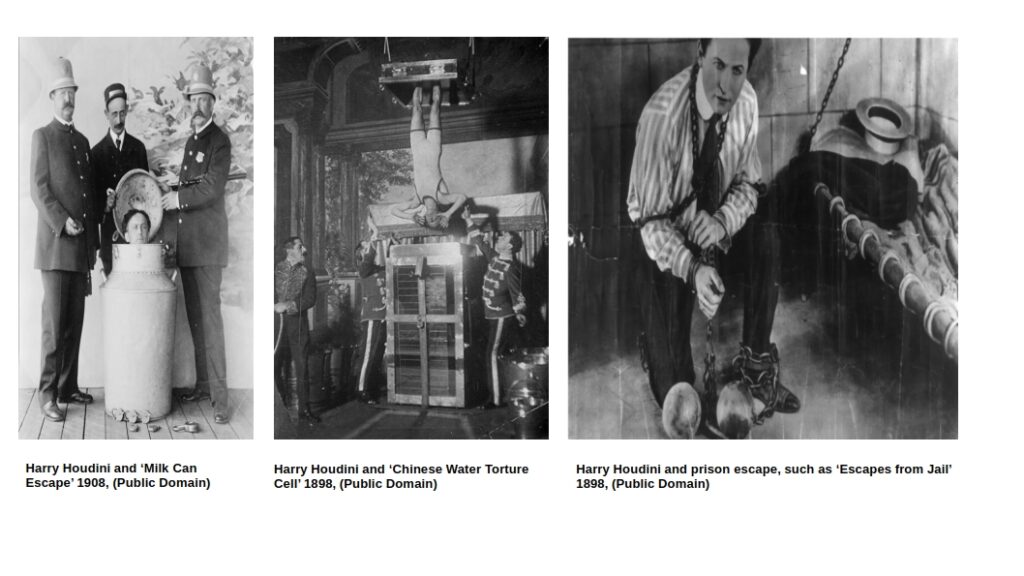
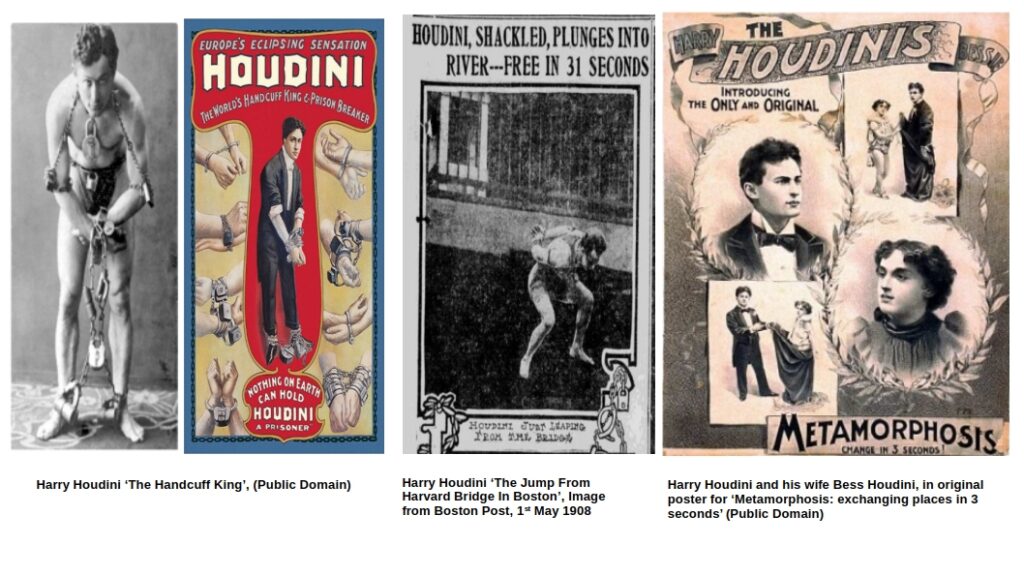
Figure 1.1.1.2: Houdini’s reputation as ‘The World’s Greatest Escape Artist’ was built on a series of iconic escapes that captivated audiences worldwide, such as ‘Milk Can Escape’, ‘Chinese Water Torture Cell’, ‘Escapes from the Ottawa Jail and the Montreal City Jail’, ‘Escape from Saran Wrap’ and ‘Metamorphosis’.
Harry Houdini’s daring feats extended beyond his famed escapes to include thrilling stunts that showcased his adventurous spirit and exceptional physical prowess. Houdini’s reputation as ‘The World’s Greatest Escape Artist’ was built on a series of iconic escapes that captivated audiences worldwide. Some of his most famous acts included:
1. ‘Milk Can Escape’: Houdini famously managed to escape from inside a sealed milk can, held underwater by his assistant. This act required immense lung capacity and the ability to remain calm and focused, even in the most challenging of situations. The magician, renowned for his prodigious feats of escapology, famously found himself enclosed within a milk can, hermetically sealed and submerged beneath the water’s surface. His assistant, a testament to the magician’s trust, held the canister aloft, subjecting Houdini to the relentless pressure of the deep. To escape, Houdini was compelled to draw upon the very essence of his being: an immense lung capacity that enabled him to hold his breath for extended periods, and an unwavering mental fortitude that allowed him to remain calm and focused amidst the most trying circumstances. This act, a symphony of physical and mental prowess, was a testament to the indomitable spirit that characterised the magician’s career. In this performance, we are reminded of the lessons imparted by the great scientists, artists, and philosophers who have sought to understand the nature of our world and the limits of human potential. Houdini’s ‘Milk Can Escape’ serves as a vivid illustration of the human capacity to conquer seemingly insurmountable challenges, a testament to the power of reason, determination, and the indomitable will to persevere.
2. ‘Chinese Water Torture Cell’: The Chinese Water Torture Cell, an act of unparalleled virtuosity, showcased the extraordinary capabilities of the renowned illusionist Harry Houdini. In this performance, Houdini was suspended inverted in a tank of water, his feet ensnared by ropes, his neck encumbered by a straitjacket, and his hands confined behind him with metal hooks. The objective of this act was for Houdini, while submerged underwater, to free himself from the straitjacket and untangle himself from the ropes. This feat demanded not only exceptional dexterity but also an unwavering patience, a testament to Houdini’s remarkable physical prowess and mental fortitude. The Chinese Water Torture Cell, with its challenging conditions, served as a poignant metaphor for the human capacity to persevere in the face of adversity
3. ‘Escapes from Jail’: Houdini’s escapes from these high-security facilities were legendary, involving complex locks and intricate security systems. These feats highlighted his ingenuity and problem solving skills, showcasing his ability to think on his feet under extreme pressure. In the annals of human accomplishment, few feats have captivated the popular imagination quite like those of Harry Houdini, the so-called ‘Handcuff King’. Renowned for his extraordinary ability to escape from seemingly inescapable restraints, Houdini transcended the realm of physical prowess, transforming his acts into meticulously crafted performances designed to mesmerise audiences and generate widespread acclaim. At the core of Houdini’s success lay a harmonious fusion of technical knowledge, physical dexterity, and a profound appreciation for the art of showmanship. A voracious student of locks and locking mechanisms, Houdini claimed to possess a ‘photographic eye’ that afforded him the uncanny ability to memorise the intricate workings of these mechanical contraptions. The prison cell served as the crucible in which Houdini’s talents were forged, and he showcased his extraordinary skills on stages across the globe, challenging local authorities to test the limits of his abilities. Each escape was preceded by a rigorous search to ensure that Houdini had no hidden tools at his disposal, followed by his confinement in a cell, and culminating in his dramatic, and often breathtaking, reappearance, having eluded his restraints. Among Houdini’s most celebrated escapes are those from the United States Jail, more specifically the infamous ‘Murderers Row’ in Washington, D.C., in 1906. Stripped and searched, Houdini was locked within a cell that housed several convicted murderers, including the cell of Charles J. Guiteau, the assassin of President James Garfield. In a remarkable display of skill and daring, Houdini managed to not only escape his cell but also open the doors of several other cells, rearranging the prisoners in the process. In the same year, Houdini’s exploits took him to Boston, where he not only escaped from his cell and handcuffs but also scaled the prison wall and reached a telephone half a mile away, all within an astonishing 20 minutes. Houdini’s exploits did not go unnoticed by the authorities, as evidenced by his booking at the Alhambra Theatre, following an impressive display of his lock-picking abilities at Scotland Yard. However, Houdini was not immune to controversy, as he found himself embroiled in a scandal involving accusations of bribery in Cologne, Germany. Undaunted, Houdini sued the newspaper and the police officer involved for slander, eventually emerging victorious in the ensuing legal battle. In order to achieve his escapes, Houdini employed a multifaceted approach, drawing upon his deep understanding of locks, his skilful concealment of tools, his prodigious physical strength and dexterity, and his keen sense of showmanship. Through this unique blend of talents, Houdini managed to transcend the boundaries of what was thought possible, leaving an indelible mark on the annals of human achievement.
4. ‘Jump from Harvard Bridge’: On the 30th of April, 1908, the renowned magician, Harry Houdini, embarked upon a daring spectacle that transpired upon the Harvard Bridge in Boston. With fervour Houdini allowed himself to be manacled and fettered by a Boston constable, subsequently leaping thirty feet into the unforgiving depths of the Charles River. This audacious act, witnessed by an estimated twenty thousand spectators, included the mayors of both Boston and Cambridge, served as a testament to the magnetic allure of Houdini’s stagecraft. As Houdini descended into the watery abyss, his shackles ensnaring him, the world held its breath, awaiting the denouement of this death defying drama. Forty seconds elapsed, and then, as if by the hand of a divine puppeteer, Houdini resurfaced, the irons in his grasp, having liberated himself from their unyielding embrace beneath the river’s surface. Houdini’s strategic deployment of such perilous stunts was not mere theatrics; they served as catalysts to engender intrigue and attract throngs to his performances. The Harvard Bridge jump was but one example of the numerous ‘bridge jumps’ that punctuated his career, a testament to his audacity and mastery of illusion. A monument, commissioned by Boston’s chapter of the Society of American Magicians, now stands as a permanent tribute to this extraordinary event, its location on the Boston side of the Harvard Bridge serving as a reminder of Houdini’s indomitable spirit and unparalleled artistry.
5. ‘Metamorphosis’: Metamorphosis Magic, a captivating and alluring form of illusion, centres around the rapid, visually striking transformations or switches of objects or people, creating the illusion of instant change or movement. This branch of magic, which can be traced back to the early 20th century, relies heavily on swift timing, misdirection, and concealment to produce breathtaking effects that leave audiences awe-inspiring. Historically, the concept of metamorphosis in magic is exemplified by the classic ‘Metamorphosis’ illusion performed by the legendary Harry Houdini and his wife, Bess. In this act, the duo demonstrated extraordinary escape artistry, coordination, and showmanship by switching places inside a locked trunk. Houdini’s version was not only a display of his incredible skill but also a theatrical spectacle that cemented the illusion’s place in magic history. In contemporary magic, the term ‘Metamorphosis Magic’ is frequently associated with acts involving a quick transformation of a person or object, often involving a sudden appearance, disappearance, or switch. Modern magicians like David Copperfield, David Blaine, and Dynamo have popularised and refined this style, bringing it to new levels of visual impact through elaborate stagecraft and innovative techniques. For instance, Copperfield’s large-scale illusions often involve rapid transformations that seem to defy the laws of physics, while Blaine’s street magic sometimes incorporates metamorphic effects that evoke surprise and wonder in everyday settings. One classic example of a metamorphosis illusion is the ‘Substitution Trunk’. In this routine, an assistant is shown to be securely bound and placed inside a trunk. The trunk is then moved across the stage, often covered or obscured from view, only to be opened moments later to reveal the assistant has seemingly vanished. In an instant, the assistant reappears elsewhere—sometimes in a different location on stage or in a different object—creating a seamless and startling switch. This illusion relies on precise timing, hidden compartments, and misdirection to convince the audience that a genuine transformation has occurred instantaneously. Overall, Metamorphosis Magic is a dynamic and visually compelling branch of illusion that combines theatrical storytelling with technical mastery. Its enduring popularity lies in its ability to evoke wonder through the seemingly impossible rapid change of objects or people, captivating audiences across generations and inspiring magicians to push the boundaries of what can be achieved on stage and beyond.
#Section 1.1.1.3: Houdini Other Works – Books
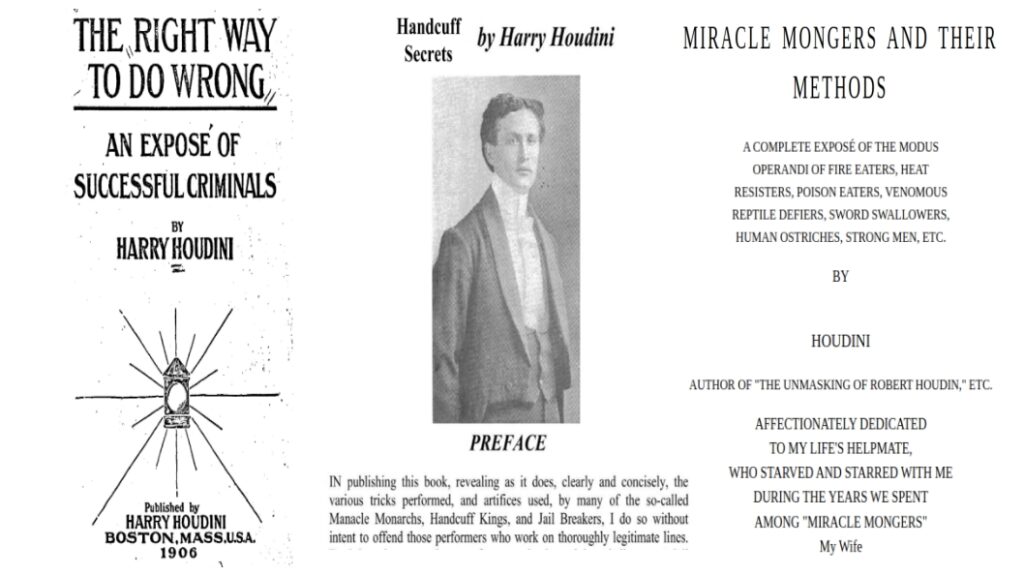
Figure 1.1.1.3: Houdini authored several books on magic, including ‘The Right Way to Do Wrong,’ ‘Miracle Mongers and Their Methods,’ and ‘Handcuff Secrets’.
Houdini authored several books on magic, including ‘The Right Way to Do Wrong,’ ‘Miracle Mongers and Their Methods,’ and ‘Handcuff Secrets’. Harry Houdini’s passion for magic extended beyond his live performances to the written word. His authorship of several books on magic served multiple purposes: educating aspiring magicians, debunking fraudulent practices, and sharing insights into the art of illusion. These works reflect his dedication to the craft and his role as a mentor to those who shared his interest in magic:
1. ‘The Right Way to Do Wrong’ (1907): In this book, Houdini aimed to demystify the methods behind common escape and illusion tricks. He provided detailed explanations of how various magic effects are accomplished, emphasising the importance of technique over mystery. By doing so, Houdini not only educated his readers on the practical aspects of magic but also encouraged them to develop their skills through hard work and practice. Let me explain. Harry Houdini’s book, ‘The Right Way to Do Wrong: An Exposé of Successful Criminals’, published in 1906, offers a detailed examination of the methods and techniques utilised by criminals during his era. The work serves both as a guide and a cautionary tale, elucidating the complexities of various criminal activities, including pickpocketing, burglary, and con artistry. The book is organised around Houdini’s interviews with police officers, criminals, and swindlers, providing readers with valuable insights into the operational tactics and psychological strategies employed by these individuals to deceive their victims. Houdini’s background as a magician enables him to analyse these methods critically, often incorporating humour alongside serious commentary on crime and deception. Key themes in the book include the exploration of criminal techniques, where Houdini emphasises the significance of skill and cunning in committing crimes. He discusses various scams and the underlying psychology, highlighting that an understanding of these methods can empower individuals to avoid becoming victims. Additionally, the book is enriched with true crime stories drawn from Houdini’s encounters with criminals, transforming it into an engaging narrative filled with real-life examples rather than merely an instructional manual. Furthermore, Houdini reflects on the ethical implications of revealing the secrets of successful criminals, prompting readers to consider the moral dimensions of deception. Overall, ‘The Right Way to Do Wrong’ transcends a simple collection of criminal exploits; it serves as a profound reflection on human behaviour, the art of illusion, and the nuanced boundary between right and wrong. Houdini’s wit and insight render this work a compelling read for those interested in crime, magic, or the psychology of deception.
2. ‘Miracle Mongers and Their Methods’ (1908): A critical examination of fraudulent practices in magic and illusion, ‘Miracle Mongers’ serves as a testament to Houdini’s commitment to integrity within the magical community. The book identifies common tricks used by charlatans to deceive audiences and offers explanations for how these tricks can be exposed. By debunking such methods, Houdini sought to protect the reputation of genuine magicians and foster an environment of honesty and transparency in the art of magic. Let me explain. In ‘Miracle Mongers and Their Methods’, Harry Houdini conducts a comprehensive examination of various performers who assert supernatural abilities, including fire eaters and sword swallowers. This work is a dual exploration, serving as both an exposé of these performers and a fascinating study of the art of illusion and deception. Houdini meticulously reveals the techniques behind their acts, providing readers with insights into the methods used to create these seemingly miraculous performances. The book critically analyses the extraordinary claims made by a range of performers, including fire eaters, sword swallowers, strongmen, and other sideshow acts. By doing so, Houdini not only exposes the methods used by these performers but also provides a historical account of their practices. This dual approach allows readers to understand both the contemporary context of these acts and their historical roots. A key theme in ‘Miracle Mongers and Their Methods’ is the distinction between genuine magic and the illusions created by performers. Houdini emphasises the difference between authentic supernatural abilities and the tricks used to simulate them, offering readers a clearer understanding of the mechanics behind these performances. The book also delves into the historical context of these acts, providing anecdotes and examples from various eras, including the Middle Ages, the 19th century, and Houdini’s own time. Houdini’s work also explores the scientific principles underlying various feats, such as fire resistance and the techniques employed in fire-eating and sword swallowing. This scientific perspective adds a layer of depth to the book, allowing readers to appreciate the skill and knowledge required to perform these acts. Throughout the book, Houdini highlights several notable performers, including the Incombustible Spaniard, Senor Lionetto, Josephine Girardelli, and strongmen like Louis Cyr and Charles Jefferson. He shares personal anecdotes about his interactions with these individuals, offering a glimpse into the world of early 20th-century entertainment and his own experiences within it. In conclusion, ‘Miracle Mongers and Their Methods’ is a multifaceted work that serves as both a critique of illusionists and a celebration of the art of performance. Houdini’s deep appreciation for the craft is evident throughout, as he maintains a critical perspective on the authenticity of these acts while acknowledging the skill and artistry involved. This balance makes the book a valuable resource for those interested in the history of performance art and the mechanics of illusion.
3. ‘Handcuff Secrets’ (1909): Dedicated to the intricacies of handcuff escapes, this book offers a comprehensive guide to Houdini’s own methods and techniques for freeing himself from various types of locks. It details how different handcuff designs can be manipulated, shedding light on the mechanical and physical skills required to execute such escapes. For aspiring magicians and curious audiences alike, ‘Handcuff Secrets’ serves as an educational resource that bridges the gap between the art of escape and the science behind it. Let me explain. ‘Handcuff Secrets’ by Harry Houdini is a seminal work that offers an in-depth exploration of the world of handcuffs, their mechanisms, and the techniques used to escape them. Published in 1909, the book is a testament to Houdini’s lifelong fascination with locks and restraints, as well as his desire to share his knowledge with both law enforcement professionals and the general public. Houdini begins by providing a historical overview of handcuffs, tracing their evolution from simple iron shackles to the more complex designs of his era. He discusses the various materials used in their construction, the different types of locks, and the innovations that have been made to enhance their security. The book is richly illustrated, featuring detailed diagrams and photographs that complement the text, making it easier for readers to understand the intricate mechanisms described. One of the key features of ‘Handcuff Secrets’ is its comprehensive analysis of escape techniques. Houdini shares his own methods, which he has refined through years of practice and performance. He explains how to identify weak points in a handcuff’s design and how to exploit them for escape. This includes discussions on lock picking, manipulating the cuffs to create space, and using tools or natural body movements to achieve freedom. The book also addresses the psychological aspects of restraint, highlighting how the mental state of the wearer can influence their ability to escape. Houdini emphasises the importance of practice and persistence, encouraging readers to develop their skills over time. Another significant aspect of the book is its focus on the role of handcuffs in law enforcement. Houdini provides insights into the selection and use of handcuffs by police officers, discussing how different designs cater to various needs, such as security, comfort, and ease of use. He also offers advice on how to maintain and repair handcuffs, ensuring they remain effective tools for law enforcement. Throughout the text, Houdini includes personal anecdotes and stories from his career, offering readers a glimpse into the world of a professional escape artist. These narratives not only add a personal touch to the book but also serve to illustrate the practical applications of the techniques and knowledge he shares. In conclusion, “Handcuff Secrets” is a unique and valuable resource that combines historical context, technical expertise, and personal experience to provide a holistic understanding of handcuffs and escape techniques. It remains a fascinating read for those interested in the art of escape and the mechanics of restraint.
#Section 1.1.1.4: Houdini Other Works – Movies

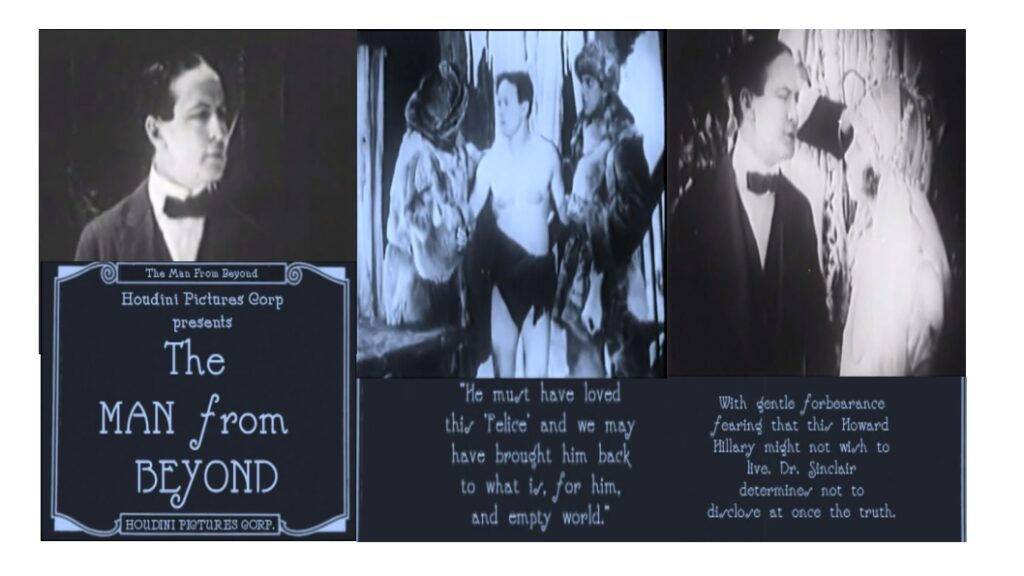
Houdini appeared in several silent films, including ‘The Man From Beyond’ (1921) and ‘The Grim Game’ (1919), which showcased his acrobatic and escape skills.
1. ‘The Man From Beyond’ (1921): The film is an example of Houdini’s unique blend of illusion and reality. In the movie, Houdini plays a character who defies death by escaping from a grave, showcasing his famed escape skills. While the film is more a piece of entertainment than a practical demonstration, it underscores Houdini’s uncanny ability to captivate audiences with the seemingly impossible. The film’s premise, involving resurrection, also hints at Houdini’s fascination with life and death, themes often explored in his real-life escapes and magic acts. Let me explain. ‘The Man from Beyond’ narrates the story of Howard Hillary, portrayed by Harry Houdini, who is discovered encased in Arctic ice by Dr. Gregory Sinclair and his expedition team. After thawing and reviving Hillary, who has been preserved for a century, Dr. Sinclair chooses not to disclose his long period of hibernation immediately, opting instead to observe Hillary’s reactions upon returning to civilisation. Upon arriving at Dr. Sinclair’s residence, Hillary encounters Felice Strange, a woman preparing for her wedding. Believing her to be his lost love, Felice from a hundred years prior, Hillary’s presence causes a disruption at the wedding ceremony. Consequently, the wedding is postponed, and Felice implores Hillary to assist in locating her missing father, Dr. Crawford Strange, who vanished while attempting to join Dr. Sinclair’s Arctic expedition. Their investigation uncovers that Felice’s fiancé, Dr. Gilbert Trent, has kidnapped her father and is confining him in his cellar. Trent’s plan involves marrying Felice and then embarking on a search for her father in the Arctic. With the aid of a clue — an initialled hat — Hillary and Dr. Sinclair identify Dr. Strange’s location, leading to a climactic sequence at Niagara Falls. Hillary chases one of Trent’s henchmen, who has taken Felice, swimming through rapids to catch up with their canoe. The story concludes with a confrontation between Hillary and Dr. Trent on a cliff, where Trent falls to his death, and Felice recognises Hillary as her true love destined for her.
2. ‘The Grim Game’ (1919): Its another cinematic gem from Houdini’s filmography, it delves into a scenario where Houdini portrays a character who must solve intricate puzzles and escape various predicaments. This film allows audiences to witness his dexterity and mental acuity first hand, as he navigates through complex situations with grace and precision. It highlights his versatility as an entertainer, not just confined to stage magic but also finding a place in the narrative medium of film. Let me explain. ‘The Grim Game’ was directed by Irvin Willat and centred on a plot involving the character of Harvey Hanford, a young newspaper reporter portrayed by the renowned escape artist and stunt performer Harry Houdini. Hanford was in love with Mary Wentworth, the ward of a wealthy and eccentric man named Dudley Cameron, who vehemently opposed their relationship. Cameron had plans for Mary to marry another man, Dr. Tyson, in order to maintain control over the Cameron estate. In a desperate attempt to save his struggling newspaper and win Mary’s hand in marriage, Hanford devised a scheme to fake Cameron’s murder. He planted false evidence implicating himself in the purported crime, intending to boost newspaper sales with the sensational story and then subsequently reveal the truth. However, the plan went awry when Cameron was actually found dead, and Hanford was framed and arrested for the murder. Leveraging his extraordinary skills as an escapologist, Hanford escaped from jail on multiple occasions, breaking out of handcuffs, chains, and even a straitjacket while suspended upside down from a building. As he pursued the real killers, Hanford confronted various dangers, culminating in a dramatic aerial chase and mid-air collision between two biplanes. After surviving the harrowing crash, Hanford was ultimately vindicated and reunited with Mary, securing both justice and the love he had fought so ardently to obtain. Throughout the film, Houdini’s remarkable talents in escape artistry, stunt performance, and aviation were prominently showcased, seamlessly blending thrilling action sequences with a melodramatic narrative. ‘The Grim Game’ served as a testament to Houdini’s versatility as a performer and his ability to captivate audiences with his daring feats and dramatic storytelling.
#Section 1.1.1.5: Houdini Also Knew
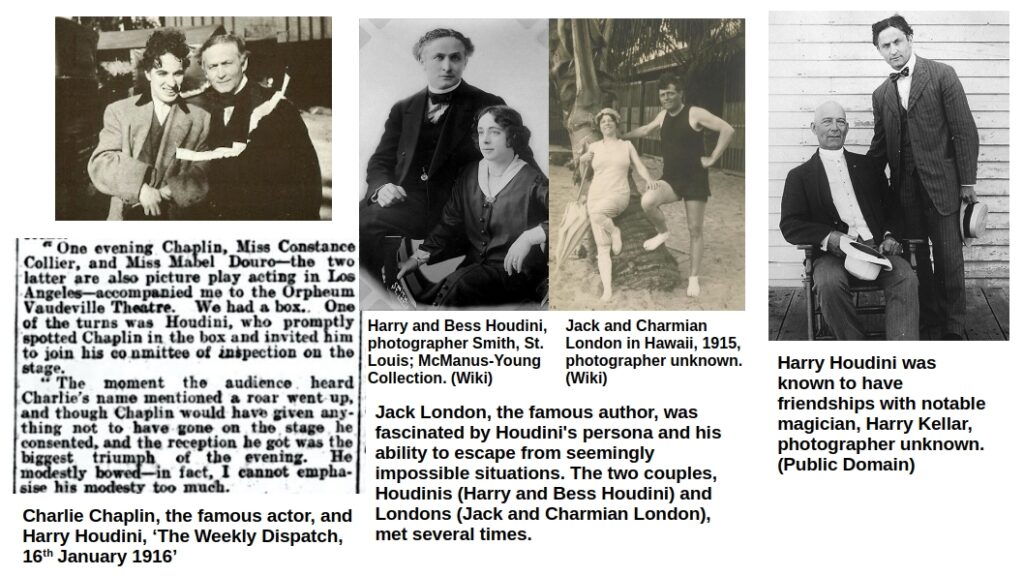
Figure 1.1.1.5A: Charlie Chaplin and Harry Houdini, Image and Quote from ‘The Weekly Dispatch, 16th January 1916’. Jack London, the famous author, was fascinated by Houdini’s persona and his ability to escape from seemingly impossible situations. The two couples, Houdinis (Harry and Bess Houdini) and Londons (Jack and Charmian London), met several times.
Images in public domain, from Wiki.
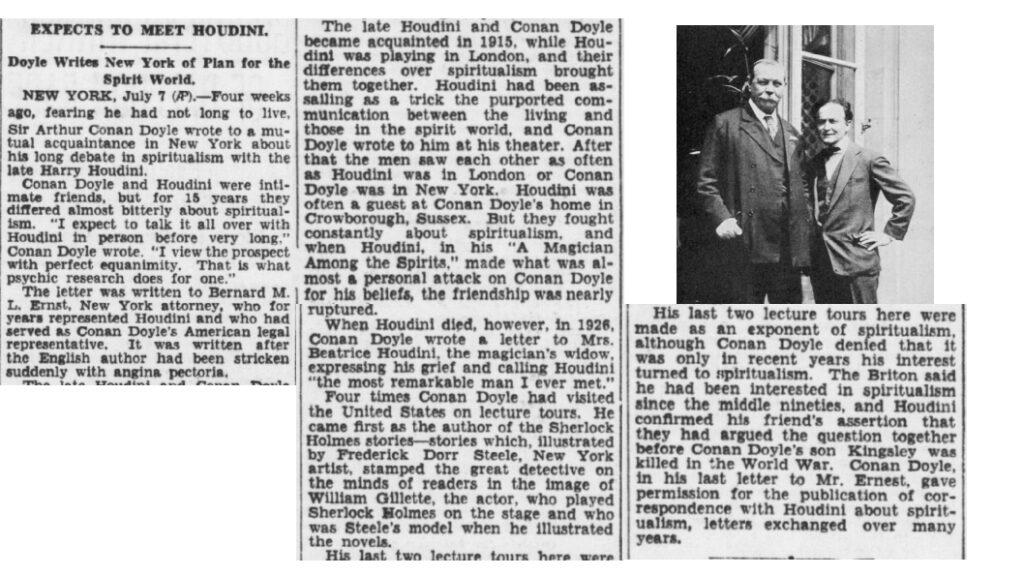
Figure 1.1.1.5B: ‘(Harry) Houdini confirmed his friend’s (Conan Doyle’s) assertion that they had argued the question (of spiritualism) together before Conan Doyle’s son Kingsley was killed in the World War. Conan Doyle, in his last letter to Mr. Ernest, gave permission for the publication of correspondence with Houdini about spiritualism, letters exchanged over many years.’ Image and Quote from ‘Evening Star 7th July 1930’.
Houdini, the iconic magician, had a wide network of acquaintances that spanned various fields, from entertainment to literature. His ability to captivate audiences and his own flamboyant personality made him an intriguing figure for many notable personalities of his time. Although direct evidence of all interactions is limited, the historical record suggests a rich tapestry of connections that underscore Houdini’s influence and fame. Houdini’s career was filled with celebrity encounters. His performances often attracted members of the press, fellow entertainers, and other notables.
1. Charlie Chaplin: Celebrities like Charlie Chaplin and Harry Houdini shared a mutual admiration for each other’s skills—Chaplin for his comedic genius and Houdini for his escapology. These two figures, each a master of their craft, are known to have crossed paths at least once, with Houdini making a notable visit to the United Artists studios in 1919—a moment that underscores the collaborative spirit of an era defined by creativity and ingenuity. Moreover, historical accounts suggest that their paths may have intersected during Houdini’s performances at the Orpheum Theatre. Notably, Houdini embarked on a week-long engagement at Seattle’s Orpheum Theatre on October 17, 1915, a period that highlights his rising prominence in the world of entertainment. Later, his performances at the Los Angeles Orpheum further cemented his legacy, particularly during a memorable encounter with heavyweight champion Jess Willard—a moment that exemplifies the extraordinary range of his talents and the magnetic draw of his performances. While there is no direct record of Chaplin being present at these specific events, intriguing narratives suggest that Houdini’s tenure at the Los Angeles Orpheum coincided with a visit from Chaplin, as noted in ‘The Weekly Dispatch’ in 1916. This subtle yet significant overlap hints at a deeper connection between these two titans of early 20th-century culture, a connection that, while not chronicled, nevertheless resonates with the intellectual and artistic ferment of the times. In the grand tapestry of history, such encounters, though brief, often leave an indelible mark, reflecting the intricate web of relationships and influences that shape the course of human achievement. The stories of Houdini and Chaplin remind us of the power of curiosity, ingenuity, and the pursuit of excellence—qualities that continue to inspire generations.
2. Jack London: Jack London was fascinated by Houdini’s persona and his ability to escape from seemingly impossible situations. In the early years of the 20th century, a most extraordinary friendship unfolded between Harry Houdini, the celebrated illusionist whose mastery of the supernatural captivated audiences worldwide, and Jack London, the renowned author whose literary genius plumbed the depths of the human condition. Their paths crossed in 1915, a year marked by the convergence of artistic innovation and intellectual inquiry, and it was during this pivotal moment that a bond of mutual admiration and intellectual synergy was forged. Houdini, a magician Extraordinaire, whose performances were not merely acts of deception but profound explorations of the limits of human ingenuity, found himself drawn to London’s literary prowess. London, for his part, was intrigued by the philosophical underpinnings of Houdini’s artistry, viewing them as metaphors for the escape from societal constraints—a theme recurrent in his own works. Their friendship blossomed into a series of intellectual dialogues, where the boundaries between illusion and reality, art and life, were explored with a rigour reminiscent of the great thinkers of antiquity. It was during one of these illuminating encounters that the two spent several days together, their conversations ranging from the mechanics of Houdini’s escape acts to the deeper philosophical questions that London sought to answer in his writings. Their shared passion for pushing the boundaries of human potential culminated in plans to meet again, a testament to the enduring strength of their connection. In a particularly vivid episode of this collaboration, London had the privilege of witnessing Houdini’s legendary escape acts first-hand at the Oakland Orpheum. The spectacle was not merely an exercise in technical skill but a profound demonstration of the human spirit’s capacity for transcendence—a theme that London would later weave into his own work, reflecting the shared philosophical world view that bound them together. Thus, the friendship between Houdini and London stands as a testament to the power of intellectual camaraderie, a bridge between the worlds of magic and literature, where the pursuit of knowledge and the exploration of human potential converged in a most extraordinary manner.
3. Harry Kellar: Harry Houdini was known to have friendships with notable magician, Harry Kellar. who was also his family and friends and often accompanied him on tours and events. The career of Kellar, a name etched into the annals of magical history, began as a series of meagre endeavours, much like the humble beginnings of many luminaries who would later shape their respective fields. He initially found employment in the peculiar sphere of spiritualism, joining the Davenport Brothers and Fay—a group that, in its own way, mirrored the esoteric and often enigmatic practices that would later define Kellar’s work. It was in this context that he began to develop the intellectual rigour and precision that would characterise his approach to magic. Kellar’s true claim to fame, however, lies in his extraordinary rendition of the Levitation, a feat that transcended the merely technical, delving into the realm of the metaphysical. The image of a young girl rising from a couch, floating across the stage, and vanishing into thin air was not merely a parlour trick; it was a testament to the boundless possibilities of human ingenuity, akin to the celestial mechanics pondered by Kepler or the invisible forces theorised by Faraday. This illusion, in its elegance and mystery, spoke to the deeper currents of human curiosity and the pursuit of the unknown. In the twilight of his career, Kellar retired to Los Angeles, a city that, like the ancient academies of Athens or the intellectual hubs of the Renaissance, became a sanctuary for the contemplative mind. It was here, in the quiet years following his retirement, that he met Harry Houdini—a figure whose name would resonate through the annals of magic. Houdini, with his relentless quest for truth and his own brand of intellectual rigour, idolised Kellar, much as a disciple might revere a master. Their friendship, a bridge between generations, allowed Houdini to chronicle Kellar’s life, ensuring that the elder magician’s legacy would endure. Houdini’s decision to perform the ‘Bullet Catching Feat’—a stunt that had already claimed the lives of several magicians—was a testament to his audacity, yet it was also a moment of reckoning. Kellar, with the wisdom of experience and the intellectual foresight of a seasoned philosopher, issued a warning, saying ‘Now, my dear boy, this is advice from the heart, DON’T TRY THE D—N Bullet Catching…no matter how sure you may feel of its success. There is always the biggest kind of risk that some dog will ‘job’ you. And we can’t afford to lose Houdini….Please, Harry, listen to your old friend Kellar who loves you as his own son and don’t do it.’ Houdini, though determined by nature, recognised the weight of Kellar’s words and heeded the advice, a moment that speaks to the power of wisdom over mere bravado. Houdini mentioned in a 1922 speech to the Club of Odd Volumes in Boston that he had a unique experience with the trick, using a large horse pistol and ensuring the committee loaded it with a marked bullet. However, he did not do the ‘Bullet Catching Feat’ atleast in public view. In 1917, a banquet was held in Kellar’s honour at the Angelus Hotel to celebrate Kellar’s artistry and intellect, with each magician presenting their own exhibitions. Kellar’s ‘Kellar Rope Tie’ and string tricks, demonstrated that evening, were not merely parlor tricks but intricate displays of mental acuity and craftsmanship. Two months later, Houdini, ever the impresario, convinced Kellar to perform once more at the Hippodrome. The performance was a grand finale, a moment that Kellar, and Houdini suggested that Kellar should be carried off in triumph on a sedan chair, saying ‘America’s greatest magician should be carried off in triumph after his final public performance.’. The sedan chair, the orchestra, and the rendition of ‘Auld Lang Syne’—all spoke to the recognition of Kellar’s enduring magical legacy. Source for Harry Kellar and Harry Houdini Quote: https://www.magician.org/blog/kellar–the-dean-of-magic?blogid=47
4. Sir Arthur Conan Doyle: Harry Houdini’s famous rivalry with Sir Arthur Conan Doyle, the creator of the fictional detective Sherlock Holmes, is a fascinating chapter in cultural history that underscores the clash between scepticism and belief in spiritualism. Their confrontation between scepticism and belief highlighted the broader cultural tensions of the time, particularly around questions of science versus spirituality, reason versus faith, and the nature of death and the afterlife. It also underscored Houdini’s status as a celebrity who could sway public opinion through his performances and public statements. Their differing views led to public debates and a series of challenges between Houdini and Conan Doyle. Houdini often exposed mediums he considered fraudulent, conducting elaborate tests known as ‘exposés’ where he would attempt to prove the mediums could not genuinely communicate with spirits. Conan Doyle countered with articles and books defending spiritualism, arguing that Houdini’s methods were insufficient to prove or disprove the existence of spirit communication. Despite their disagreements, both men were influential in their respective fields—Houdini as an entertainer and mystery solver, and Conan Doyle as a literary genius and advocate for spiritualism. Their interactions and the discourse they generated continue to be studied for insights into the cultural dynamics of their era. In essence, Houdini and Conan Doyle’s debates over spiritualism encapsulate the broader intellectual and cultural battles of the early 20th century, where traditional beliefs were being challenged by new scientific understandings and critical thinking. Their exchange serves as a reminder of how deeply personal experiences can shape public beliefs and how influential figures from vastly different fields can engage in spirited debates that transcend their primary areas of expertise.
#Section 1.1.1.6: Houdini Lives On
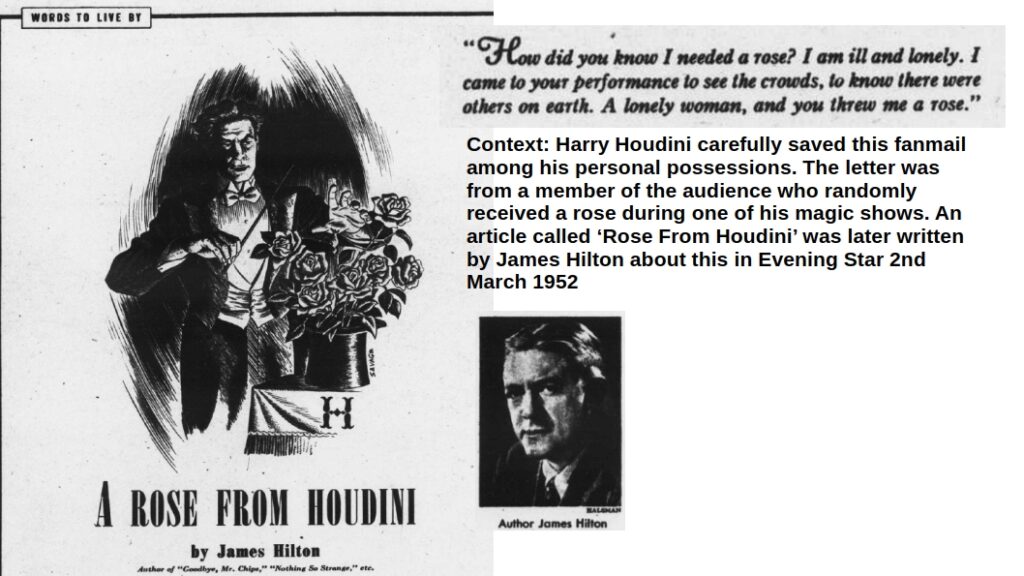
Figure 1.1.1.6: ‘Rose from Houdini: Of all the countless ‘fan’ letters he had received this was the one he
evidently valued the most and took most pains to preserve….For it is not given to many writers to express so movingly the ache of the human heart, nor is it given to many artists to receive such a tribute’…’How did you know I needed a rose?’…’Perhaps he didn’t. But in that chance gesture from the stage, so casual, perhaps in a way so accidental and impersonal, there came a contact never to be forgotten — a touch on the nerve of life itself.’by Author James Hilton Image and Quote from ‘Evening Star 2nd March 1952.’
In addition to these thrilling performances, Houdini played a pivotal role in the world of magic by founding the Society of American Magicians (S.A.M.) in 1902. This organisation was established with the intention of fostering camaraderie and professionalism among magicians. Over time, S.A.M. has grown into the largest and oldest organisation of its kind, boasting a membership of over 4,000 professionals and enthusiasts. Houdini’s vision for S.A.M. was to create a community where magicians could share knowledge, skills, and ethical standards. By doing so, he not only advanced the art of magic but also ensured its preservation and respect within popular culture. The society provides a platform for learning, networking, and collaboration, continuing Houdini’s legacy of promoting magic as an art form worthy of admiration and study. Houdini was known for his kindness and generosity. He often used his platform to help those in need, such as donating to charities and offering support to families of entertainers who had passed away. His compassion and humanitarian spirit are less well-known but played a significant role in shaping his legacy as a person. Houdini, the legendary magician, showed a side often hidden behind his dazzling performances by saving a fan letter about the ‘Rose from Houdini.’ Amid his personal treasures, a letter was found, its existence a testament to the emotions he cherished and his deep understanding of the human condition. The letter posed a poignant question: ‘How did you know I needed a rose?’ from an audience member who had unexpectedly received a rose from Houdini, and this uplifted the spirit of this ill and lonely woman, prompting her to write the fan mail to Houdini. Even in a world of grand spectacles and monumental changes, it’s the small, heartfelt moments that leave lasting impressions.
By combining his magical prowess with his personal ambition, Houdini left an indelible mark on the American public, inspiring future generations to explore the limits of human potential. Beyond entertainment, Houdini was involved in humanitarian efforts, using his fame to draw attention to issues such as spiritualism, where he exposed fraudulent mediums in a series of well-established exposures. His fight against these ‘mystics’ underscored his commitment to truth and justice. The art of magic, in its various forms, continues to be a testament to the boundless human imagination. Houdini’s impact is realised by the fact that his name has become a noun, which according to Oxford dictionary means ‘a person or an animal that is very good at escaping’!
Acknowledgements
Knowledge Sources Used In Research:
- Bibliography: Major sources have been cited in the text and images. These will also be cited again at the end of the chapter.
- Search Engine and Encyclopedia: Search engines such as Startpage, Ecosia, Qwant, Brave, DuckDuckGo and encyclopedia such as Wikipedia, Britannica, Oxford and Cambridge Dictionaries.
- Public Domain Resources: Books, Video screenshots, Newspapers and Images from public domain.
Review:
- Large Language Models (Mistral AI, Cohere Aya, EuroLLM, Qwen, DeepSeek, and ChatGPT) have been used for feedback only, and not for writing. This is in keeping with the three reviewer requirement which most high tier academic journals accept as standard.
- Content not deemed appropriate for all age groups has been omitted at the discretion of the author.
- The text is written in British English taking into consideration that potential readers could be global and not just from US.
Author(s) and Author(s) Contribution:
- Goldy Honorer-Descartes (born Shradha Mukherjee) is the sole author of this content, including and not limited to ideation, research, writing and making figures.
- Goldy Honorer-Descartes pen name/nickname/preferred name in honour of my intellectual father Rene Descartes. The French ‘Honorer Descartes’, translates to ‘Honouring Descartes’).
Coming Soon:
- Suspense from Hitchcock and Fairyland of Disney.
- There’s a saying that ‘Variety is spice of life’. Thus, after covering above US legendary trio, author will switch gears to cover other chapters i.e. other countries.
- For the other chapters i.e. other countries, author will cover legendary trios from China, Japan, Germany, France, Italy, Greece, Spain, Portugal, Denmark, Sweden, Norway, Finland, Netherlands, Austria, Poland, Belgium, Switzerland, Czech Republic, UK, Australia, New Zealand and Canada.
- Each country will comprise a chapter, and will include more than three legends. However, just for start only three will be covered.